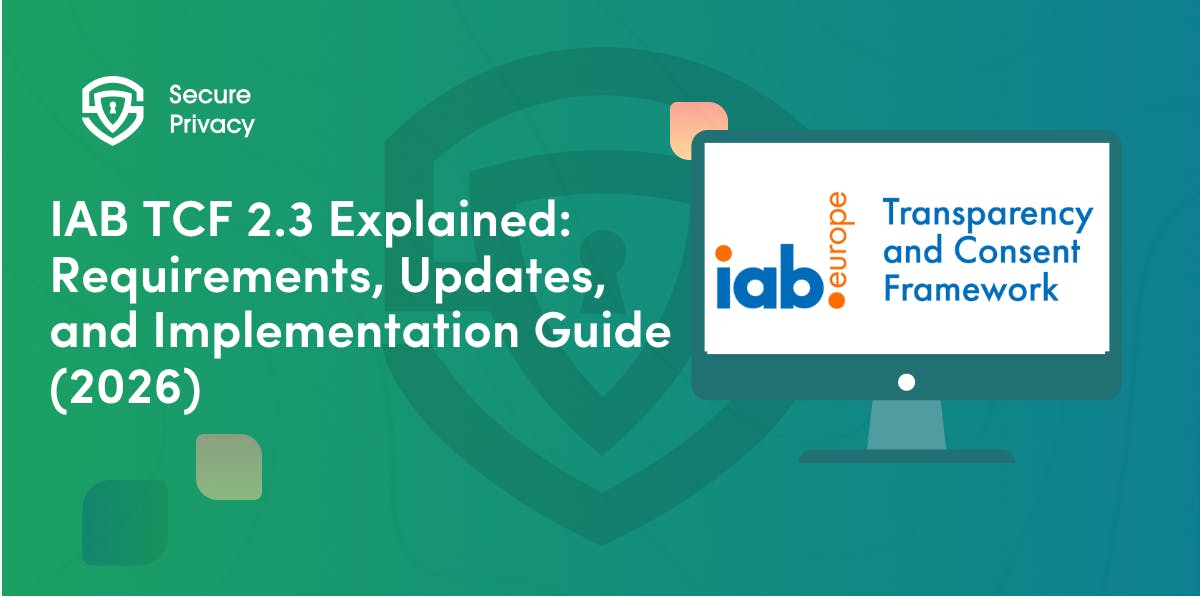Your VR Headset Is Watching: The Hidden Biometric Compliance Crisis in Immersive Tech
That VR headset tracking your eye movements at 120 frames per second isn't just creating immersive experiences—it's generating detailed biometric profiles that fall under some of the world's strictest privacy laws.
While you're exploring virtual worlds, the technology is mapping your iris patterns, analyzing your emotional responses, and recording movement signatures unique to your body.
These capabilities have transformed VR and AR devices into sophisticated biometric collection systems that often operate without meaningful consent. As regulators catch up to the technology, companies developing immersive experiences face a complex web of compliance requirements across GDPR, CPRA, BIPA, and emerging AI regulations.
The stakes are substantial: getting biometric consent wrong in VR/AR can trigger millions in penalties and class-action lawsuits. Yet most developers are still treating these powerful sensors as simple input devices rather than biometric scanners requiring specialized privacy protections.
The Invisible Biometric Collection in Your Living Room
Modern VR and AR systems collect far more biometric data than most users realize, often without clear disclosure or proper consent mechanisms.
What Your Headset Actually Sees
VR systems continuously capture multiple biometric signals:
- Eye tracking data: Pupil dilation, gaze patterns, blink rates, and saccadic eye movements that create unique identification patterns
- Head movement signatures: Three-dimensional positioning coordinates and rotation patterns that reveal distinctive kinematic profiles
- Facial muscle activity: Micro-expressions captured through integrated cameras or inferred from head movement patterns
- Haptic responses: Hand grip pressure, finger positioning, and tactile feedback patterns that form behavioral biometrics
AR glasses add additional layers:
- Environmental biometrics: Facial geometry captured during spatial mapping and object recognition
- Gaze heatmaps: Precise tracking of what captures your visual attention in real-world environments
- Emotional inference: Sentiment analysis based on viewing patterns and micro-expressions
The Composite Profile Problem
While individual data points might seem innocuous, their combination creates comprehensive biometric profiles. The GDPR recognizes that datasets become biometric when "resulting from specific technical processing" that enables identification—even if components appear anonymous individually.
For example, your unique way of coordinating head movements while reaching for virtual objects creates a kinematic signature as distinctive as a fingerprint. When combined with eye tracking patterns and haptic responses, these datasets enable re-identification across sessions, platforms, and even physical locations.
This composite approach to biometric identification means that VR/AR systems often trigger privacy protections without developers realizing it.
The Regulatory Maze: Multiple Laws, Conflicting Requirements
VR and AR developers must satisfy overlapping privacy frameworks that weren't designed for immersive technologies.
GDPR's Explicit Consent Challenge
European law requires explicit consent for biometric processing, but traditional consent mechanisms break down in immersive environments:
- Interface limitations: Standard consent forms don't work well in VR environments where text is difficult to read
- Continuous processing: Unlike web forms, VR systems collect biometric data throughout entire sessions
- Purpose specification: Users must understand exactly what biometric data is collected and how it's used
- Withdrawal mechanisms: People need ways to revoke consent without complex menu navigation
The EU AI Act adds another layer by classifying many VR emotion recognition and biometric categorization systems as "high-risk AI" requiring additional safeguards and transparency measures.
Recent European Data Protection Board guidance mandates that VR consent interfaces must isolate consent collection from general terms of service, provide real-time processing indicators through in-environment displays, and enable withdrawal through simple voice commands.
BIPA's Strict Liability Standard
Illinois' Biometric Information Privacy Act creates significant litigation risk for VR/AR systems. BIPA requires:
- Written notice before collecting biometric identifiers
- Written consent separate from other agreements
- Retention schedules publicly disclosed before collection begins
- Deletion upon purpose completion or within three years maximum
The 2024 Charlotte Tilbury settlement established that virtual try-on features constitute biometric data collection under BIPA, requiring separate notifications for facial geometry processing and annual consent reaffirmation.
Unlike GDPR's regulatory enforcement model, BIPA enables individual lawsuits with damages up to $5,000 per violation. This creates substantial financial exposure for VR platforms with large user bases.
CPRA's Auto-Deletion Requirements
California's updated privacy law treats biometric data as "sensitive personal information" requiring:
- Limited retention periods with automatic deletion when purposes expire
- Granular consent allowing users to accept some biometric processing while declining others
- Real-time controls enabling users to limit sensitive data processing mid-session
- Deletion workflow coordination across third-party developers and analytics providers
CPRA's requirements become particularly challenging for VR platforms that rely on persistent user profiles for functionality, as the law mandates automatic deletion of biometric data once original collection purposes expire.
Technical Implementation Challenges
Building compliant biometric consent for VR/AR requires solving technical problems that don't exist in traditional software.
Consent in Three-Dimensional Space
VR consent interfaces must work within the constraints of immersive environments:
Spatial consent dialogs that appear as floating interfaces within virtual environments, positioned to avoid motion sickness while ensuring visibility.
Gaze-activated controls allowing users to consent through eye movements, but with appropriate safeguards preventing accidental activation.
Voice command integration enabling consent withdrawal through speech recognition without requiring menu navigation.
Haptic feedback notifications alerting users when biometric processing begins or changes intensity.
These interfaces must balance regulatory requirements with user experience constraints unique to immersive technologies.
Data Minimization in Continuous Collection
VR systems face inherent conflicts between functionality and privacy requirements:
Foveated rendering requires eye tracking to optimize graphics performance, but creates detailed gaze pattern records.
Spatial mapping needs environmental scanning for AR object placement, but captures facial geometry as incidental biometric data.
Motion prediction uses movement patterns to reduce latency, but generates behavioral biometric signatures.
Compliance solutions include:
- On-device processing of raw biometric signals into anonymized metadata before cloud transmission
- Differential privacy techniques adding statistical noise to movement datasets while preserving functionality
- Purpose-limited data flows ensuring biometric data used for rendering doesn't migrate to analytics systems
Cross-Platform Deletion Coordination
CPRA's auto-deletion requirements become complex when VR experiences involve multiple parties:
- Game engines processing biometric data for gameplay features
- Analytics providers collecting aggregated movement data for platform optimization
- Third-party developers accessing biometric APIs for specialized applications
- Hardware manufacturers storing calibration data linked to individual users
Effective deletion workflows require:
- Blockchain-based deletion ledgers providing immutable compliance documentation across parties
- SDK-level data lifecycle management with automatic cleanup when retention periods expire
- Machine-readable retention policies embedded in biometric metadata for automated compliance
Emerging Solutions and Standards
The immersive technology industry is developing specialized approaches to biometric consent management.
Privacy-Preserving Architecture Patterns
Leading VR platforms implement several privacy-preserving design patterns:
Local processing models that analyze biometric data on-device and only transmit anonymized insights rather than raw biometric identifiers.
Federated learning approaches that improve algorithms through distributed training without centralizing biometric data.
Homomorphic encryption enabling analytics on biometric data while keeping individual identifiers encrypted throughout processing.
Zero-knowledge proofs allowing verification of user characteristics without revealing the underlying biometric data.
These approaches maintain VR/AR functionality while minimizing privacy risks and regulatory exposure.
Industry Standards Development
The Immersive Technology Standards Consortium is developing VR/AR-specific consent protocols featuring:
- Haptic feedback notifications for biometric processing start and stop events
- 3D spatial consent interfaces using volumetric displays for improved comprehension
- Biometric data flow visualizations showing users how their data moves through VR systems
- Standardized consent APIs enabling consistent privacy controls across VR platforms
These standards aim to create industry-wide approaches to biometric consent that work consistently across different VR/AR platforms and applications.
Compliance Implementation Framework
Organizations developing VR/AR systems should implement biometric consent management through this systematic approach:
Phase 1: Biometric Data Assessment
- Inventory all sensors in VR/AR devices capable of capturing biometric information
- Map data flows showing how biometric data moves between system components
- Classify processing purposes linking each biometric collection to specific functionality
- Evaluate jurisdiction exposure based on target markets and applicable privacy laws
Phase 2: Consent System Development
- Design immersive consent interfaces adapted to VR/AR interaction paradigms
- Implement granular permission controls allowing selective biometric processing consent
- Create real-time notification systems alerting users to biometric data collection
- Develop withdrawal mechanisms enabling easy consent revocation during sessions
Phase 3: Technical Privacy Controls
- Deploy on-device processing to minimize biometric data transmission
- Implement automated deletion workflows triggered by retention policy expiration
- Create audit logging systems documenting all biometric processing activities
- Establish third-party coordination for ecosystem-wide consent management
This framework addresses the unique challenges of managing biometric consent in immersive environments while satisfying regulatory requirements across multiple jurisdictions.
The Path Forward for Responsible VR/AR
The biometric compliance challenge in VR/AR reflects broader tensions between technological innovation and privacy protection.
Industry Consolidation Around Privacy
Leading VR/AR companies are recognizing that privacy compliance isn't just a legal requirement but a competitive advantage:
- User trust becomes a differentiating factor as privacy awareness increases
- Regulatory approval enables expansion into privacy-conscious markets
- Risk mitigation protects against costly litigation and regulatory penalties
- Technical innovation often emerges from privacy-preserving design constraints
Organizations that build robust biometric consent systems early will be better positioned as regulations tighten and consumer expectations evolve.
Preparing for Expanded Regulation
Several regulatory developments will likely impact VR/AR biometric compliance:
- Expanded BIPA enforcement as more states adopt similar biometric privacy laws
- GDPR updates specifically addressing immersive technology challenges
- AI Act implementation creating additional requirements for VR emotion recognition systems
- Federal privacy legislation potentially establishing national biometric protection standards
Building flexible, comprehensive consent systems now helps future-proof VR/AR products against evolving regulatory requirements.
Conclusion: Immersive Technology That Respects Privacy
VR and AR technologies offer unprecedented opportunities for human-computer interaction, but their biometric collection capabilities create equally unprecedented privacy responsibilities. The current compliance crisis stems from treating these powerful sensors as simple input devices rather than sophisticated biometric scanners requiring specialized protections.
Success in this environment requires recognizing that meaningful consent in immersive technologies demands new approaches to user interface design, data processing architecture, and privacy engineering. Traditional consent mechanisms developed for web browsers and mobile apps simply don't work in three-dimensional immersive environments.
Organizations that invest in proper biometric consent systems will not only satisfy regulatory requirements but also build user trust essential for long-term adoption of immersive technologies. The alternative—treating privacy as an afterthought—risks both regulatory penalties and user rejection of VR/AR platforms that feel invasive rather than empowering.
Frequently Asked Questions
Do I need special consent for eye tracking in VR headsets?
Yes, in most cases. Eye tracking generates biometric data that requires explicit consent under GDPR and may qualify as biometric identifiers under laws like BIPA. Even if used solely for foveated rendering, the detailed gaze patterns created can enable user identification, triggering biometric protection requirements.
How does BIPA apply to VR companies not based in Illinois?
BIPA applies to any company collecting biometric data from Illinois residents, regardless of where the company is based. Since VR platforms typically serve users nationwide, they must comply with BIPA for all users unless they can reliably exclude Illinois residents—which is generally impractical.
Can I use general terms of service for VR biometric consent?
No. GDPR requires explicit consent separate from general terms, and BIPA requires written consent specifically for biometric collection. Burying biometric consent in lengthy terms of service violates both frameworks and creates significant legal exposure.
What's the difference between biometric data and behavioral data in VR?
The distinction often depends on how the data is used rather than what's collected. Movement patterns used for avatar animation might be behavioral data, but the same patterns used for user identification become biometric data. When in doubt, most legal experts recommend treating VR sensing data as biometric to ensure adequate protection.
How long can I retain VR biometric data?
This varies by jurisdiction and purpose. GDPR requires deletion when purposes are fulfilled, CPRA mandates automatic deletion when no longer necessary, and BIPA allows up to three years maximum. Many VR platforms implement session-based deletion (purging biometric data when users log off) to minimize compliance complexity across jurisdictions.
Get Started For Free with the
#1 Cookie Consent Platform.
No credit card required

What is Cookie Consent? A Quick 2026-Ready Glance
Your website loads. Cookies track users. But without proper cookie consent, you're violating GDPR — risking fines up to €20 million or 4% of global revenue. Cookie consent is the legally required mechanism by which websites obtain explicit user approval before deploying non-essential tracking technologies. This requirement stems from GDPR Article 4(11) and the ePrivacy Directive, mandating that consent must be freely given, specific, informed, and unambiguous.
- Legal & News

DSAR Tools Explained: Best Software for Automating Privacy Requests
You're drowning in data subject access requests. Manual searches through dozens of systems miss regulatory deadlines and expose organizations to fines starting at $2,500 per violation. The solution? DSAR tools — purpose-built software that automates the entire process of responding to data subject access requests, from intake to delivery.
- Legal & News

IAB TCF 2.3 Explained: Requirements, Updates, and Implementation Guide (2026)
Your ad revenue dropped 40% overnight. Google stopped bidding on your inventory. Your DSP partners flagged your traffic as non-compliant. The culprit? An outdated TCF 2.2 consent string after the February 2026 enforcement deadline.
- Legal & News
- Cookie Consent

